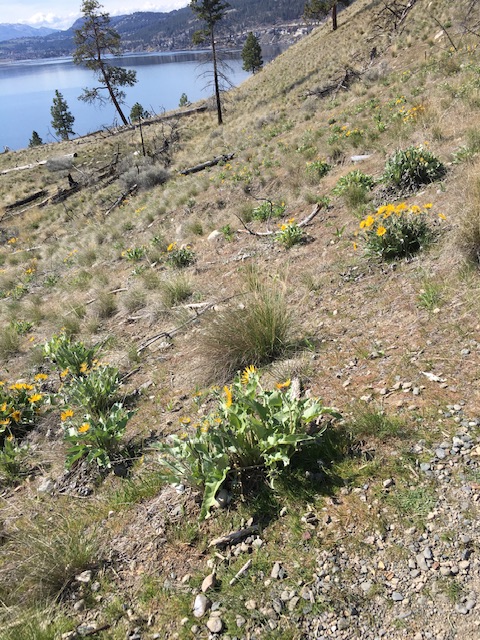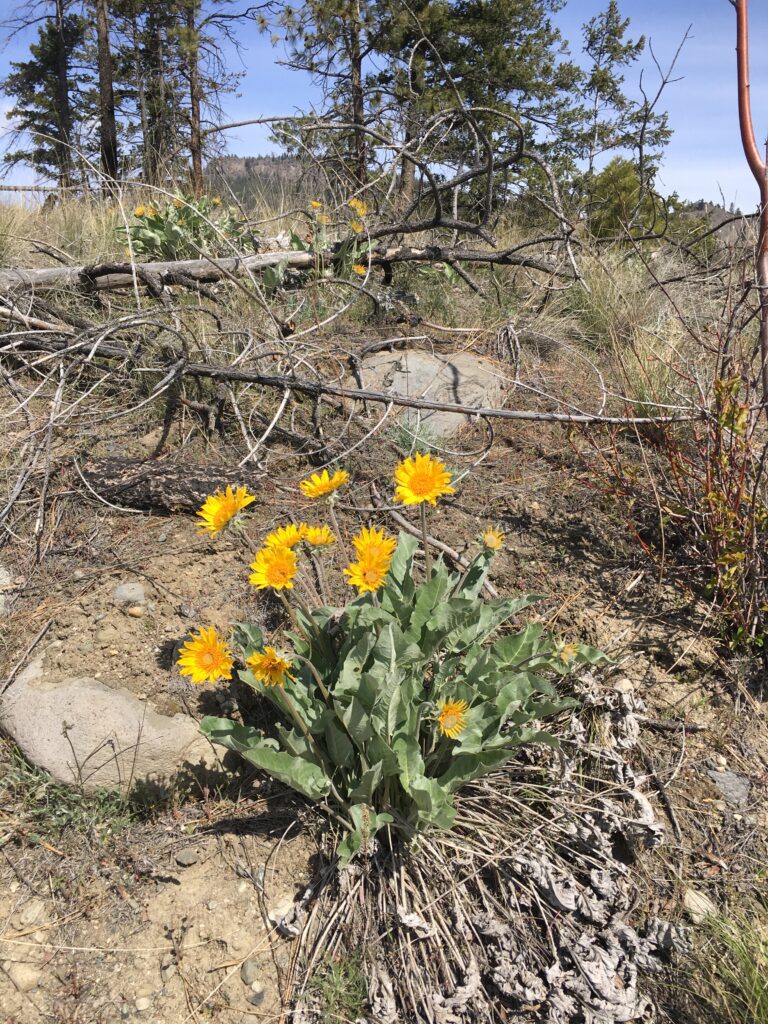Introduction: Our Guide’s Creation Story
Our Guide’s Creation Story
This project took place on Syilx Okanagan Peoples’ lands. We recognize the sovereignty of Syilx Okanagan Peoples and their right to their Lands and Waters from time immemorial to present day and beyond.
smúkʷaʔxn (Arrowleaf Balsamroot)
The creation of this Indigenous university writing guide involved a collaborative and inquiring process. We wondered how the teaching of university writing might be indigenized in order to support Indigenous students in the most meaningful and culturally informed ways on their way to achieving writing success at university. We asked related questions such as what does indigenizing mean and what might the implications be for instructors and learners? Other questions we asked were: Why was such a guide needed? Who would the guide be geared toward?
As instructors teaching academic writing and academic writing for Indigenous students and in particular Indigenous students in the Indigenous Access Program at the University of British Columbia’s Okanagan campus, we noticed that there were almost no resources in existence for the purpose of supporting Indigenous students. Further, there were few resources that were situated in local Indigenous Peoples’ educational teachings, or from their perspectives and histories. Three resources that do exist at Canadian universities and were inspirational for us at the time of our guide’s development were: Royal Roads University’s Four Feathers Writing Guide, Toronto Metropolitan University’s Four Directions Writing Guide and Wilfred Laurier University’s Academic Writing Manual for Aboriginal Students. We realized that there was a need for a more detailed, Interior Salish guide for writing academically that included Indigenous intellectual traditions. We wondered how opportunities to write indigenously might be made possible by re-conceptualizing academic writing. There was a need for this guide to be situated in and guided by local Syilx Peoples’ contexts and knowledges and that could also speak to Indigenous students from other locales.
The guide would be geared to First year students and any students who need a refresher. As well, we thought the guide would be educational and helpful for instructors. We saw this work as serving to provide guidance in two ways: Connecting to and navigating standard academic writing and communication and also finding ways to include Indigenous Peoples’ teachings regarding ways of communicating knowledge. We tried to identify principles in common and in difference behind communicating and writing: for example, in citation practices.
We created a graphic to illustrate the places of overlap. We identify connections and distinctions between Indigenous ways of knowing and communicating and those of non-Indigenous academic discourse communities throughout the different sections of the guide. Based on the Indigenous students’ feedback in the focus groups we held, we tried to incorporate multimodal components in the guide. Students had asked for downloadable components and visual conceptual models.
We performed an environmental scan to search for similar guides and related programs at universities and other educational organizations or in communities. The most relevant resources are listed at the end of this guide. We also performed a literature review with the help of the UBC Okanagan Librarian. The literature review provides the results of studies that show what works best to support Indigenous students’ learning and are evidence that the kind of culture and local guide we created would go a long way in supporting the students in achieving the standard learning outcomes and expectations of academic writing, while simultaneously building on time honoured culturally situated ways of learning and communicating that maintain Indigenous Peoples’ cultural values.
At the outset we recognized that the local Indigenous nations are the rightful, unceded, leaders of the land where our university is situated, and in particular regarding relationships involving land and between land and language. The project was grounded in a recognition of how Indigenous Knowledges (IK) and Land ethics, or Traditional Ecological Knowledge (TEK), are embedded in Indigenous languages. In this regard the project was informed by movements to revitalize Indigenous languages, to indigenize curriculum, and to understand the Indigenous canon and Indigenous style (Kirkness, Archibald, Armstrong, Younging), by Indigenous communities’ concerns regarding IK in the public domain (Smith, OCAP, McCracken and Hogan), and by recent calls for linguistic justice within composition studies (Horner et al.). Through a Syilx advisory (Jeannette Armstrong, Marlowe Sam, Bill Cohen), we sought to situate the guide in Syilx contexts, Knowledges, values, ways of knowing and communicating, stemming from mutually reciprocal TEK ethics in regard for, and in relationship with Land.
We thought it important that the Indigenous writing guide be accessible through a digital OER platform to lessen financial burdens on students. However, the publication of the guide in a highly accessible high-speed platform raised questions regarding the ethics when sharing Indigenous Knowledges (IK) and how to protect IK from misuse, mis-contextualization and/or from being used for profit and financial or other gains by individuals and companies. In the high-speed proliferation of digitalized knowledge, guidance and care are needed in navigating the nuanced, layered ethics for working with, citing and sharing Indigenous Knowledges in academia and beyond. These concerns would be important for students and instructors to consider. For our project we engaged with IK that was published in the public domain (websites, museums, libraries, articles, books and so on); however, we were cognizant of the fact that a substantial amount of IK has historically been taken and mis-contextualized and so could be in the public domain.
We asked how can one assess the validity of the source of IK and how can one ensure appropriate protection of IK is in place after it has reached the public domain? We adhered to criteria that we created for how to best assess the IK we accessed in the public domain. Further, we were aware that we might be engaging with IK in our conversations with the Syilx advisory and with the Indigenous students who shared about their writing experiences and visions in the Indigenous student focus groups. In instances where IK might be shared with us, we asked for permission from the person before including a quotation from them in the guide.
We felt it was imperative to include student input into the project and this was achieved in two ways; through the hiring of graduate, undergraduate and work study student research assistants and through the holding of a series of Indigenous student focus groups. The student research assistants were involved in every step of the project starting with the environmental scan. What the students told us in the focus groups guided our understanding of what the students found to be most helpful and what they felt they most needed in their academic writing education. It was evident that the students had already been thinking about their writing education and they readily and enthusiastically shared their experiences and their vision for how to improve the teaching of writing. Some students had created and were already working with conceptual writing models aligned with Indigenous epistemology and world view that were circular rather than linear. We share further highlights from the students’ insights into their writing later in the guide through quotations, graphics and media.
In an attempt to depart from euro-centric linearity, the guide is organized in four circles and eight chapters that align with Indigenous Peoples’ concepts of wholism, fours, interrelatedness, synergy, inclusivity and diversity. The guide includes Syilx Peoples’ teachings, concepts and terms in Nsyilxcən (language), along with conceptual models and graphics, samples of student work, and reflective activities at the end of each chapter and circle.
The team leading the development of the guide came from diverse standpoints. We are undergraduate and graduate students, an assistant professor of teaching, and an associate professor of teaching. We are a mix of Indigenous and ally collaborators. Coming from our diverse backgrounds we asked questions such as if we understand that Indigenized academic writing can hold, express and exemplify Indigenous Knowledge (IK) then what does it mean and what are the implications of a diversity of identified peoples, who may or may not have lived Indigenous realities, teaching and learning from a land-based Indigenous writing and pedagogy guide that holds and expresses IK? In what ways might different people teach and be taught from the guide? How might student work be assessed differently when writing Indigenously? The answers to these questions are in process and perhaps readers of this living guide might engage in asking these questions themselves and arrive at further answers. Overall, we hope the guide will support and benefit Indigenous students and their instructors.
The nysilxcn phrase, “Kʷu cyʕap” at the beginning of the title of the writing guide, Kʷu cyʕap: A locally situated Salishan tmixʷ-centered and land-based Indigenous writing guide, translates to “We have arrived” in english and is a part of a greeting often heard in greetings at the beginning of Syilx led gatherings and we think it is apt for this writing guide which marks an arrival of Syilx and Indigenous Peoples’ ways of communicating knowledge both traditionally and emergent in “writing” at the university.
Readings/Videos/Sound Recordings
1. Who are the Syilx People?
Video: Dr. Bill Cohen narrating. “Who are the Syilx? Tradition Part 1 of 2.” SAGA.com productions. November 3, 2018.
Teachings/Reflective Questions
2. How is the word Syilx pronounced?
3. How is Kʷu cyʕap pronounced?
How to pronounce kʷu cyʕap (translation to english: we have arrived)
4. What does smúkʷaʔxn (Arrowleaf Balsamroot) teach us? What are the teachings/guidance of smúkʷaʔxn (Arrowleaf Balsamroot)?


